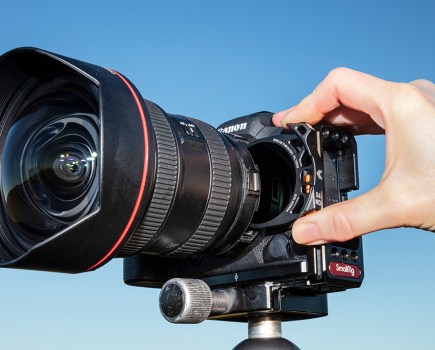Nissin Di700A – At a glance
- Price: £200
- Website: www.nissindigital.com
Just a few years ago, shooting with off-camera flash was prohibitively expensive for most amateur photographers. If you wanted to buy a high-end flashgun, transmitter and receiver set-up you needed a fairly large amount of cash. However, in the past few years, companies such as Yongnuo, Hähnel, Phottix, Cactus Imaging and Nissin have produced a variety of inexpensive triggering systems that are very impressive. In fact, Nissin showed what it is capable of last year when its i40 flashgun won Accessory of the Year at the 2015 Amateur Photographer Awards. We concluded that it was the best flashgun for compact system cameras while also being very affordable.
Nissin has now turned its attention to off-camera flash, using the Nissin Di700 flashgun as the foundation for the new Nissin Di700A. The company has added a wireless radio receiver built into the flash unit that then pairs with a brand-new Nissin Air 1 Commander unit. This allows users to manually control the flashgun wirelessly off-camera with TTL metering – and the best part about the Nissin Di700A is that it costs around £200.
Nissin Di700A – Features
The headline feature of the Nissin Di700A flashgun is the 2.4GHz radio receiver that’s built into the unit, so an additional receiver attachment is not required to fire the flashgun. The Nissin Air 1 Commander transmitter is capable of directly communicating with the Nissin Di700A flash and allows control of the flash settings wirelessly, as well as being able to trigger the flash on command.

This image was taken with two Nissin Di700A units – one with a softbox positioned to the left and one with a spotlight grid and pink gel on the background
Radio technology is widely considered to be the most reliable of any communication between a receiver and transmitter, as it does not require line-of-sight transmission like infrared or optical triggering. Wireless is a much better option when shooting on location, as it allows photographers to position the flash behind the camera, a wall or around a corner and – provided it’s in range – will fire without a problem. That’s difficult to do with optical or infrared systems. Nissin claims to have a usable range of 30 metres between flash and commander.
The second big feature of the Nissin Di700A flashgun is TTL metering. In the past, TTL has been the preserve of expensive flash-triggering systems. Using the Nissin Air 1 Commander, the Di700A emits a small pre-flash before the main exposure, allowing the camera to automatically gauge the power output required from the flashgun to achieve a good exposure. Effectively, this is full automatic mode, and it’s all available off-camera as well as on-camera.

When the subject moves erratically, the only way to get consistent results is using TTL flash metering
With the Air 1 Commander, users can manually adjust the TTL exposure of the flashgun by ±2EV in 1⁄3-stop increments. Flash-exposure compensation can also be adjusted on the camera to achieve ±3EV compensation. Featuring three groups (A, B and C), plus seven channels, it’s possible to control up to 21 flashes at a time. I found it useful to put a key light on group A, a fill light on group B and a hair light on group C. The Nissin Air 1 Commander then allowed me to control these settings independently in both manual and TTL until I achieved my desired balance between lights.
At present, there are no additional receivers to adapt other flashguns and integrate them into Nissin Air system, although Nissin has stated that some are due to be released later this year. Currently, though, if you are using the Air 1 Commander, you won’t be able to use the radio control to fire any other flash units, which is a disadvantage for anyone who already has a flash kit. The only workaround is to use flashes in the manual-power setting and trigger them using an optical slave, but this means you lose wireless control.
Two slave modes – SD and SF – are available with the Nissin Di700A. SD stands for slave digital, and in this mode the flash is designed to ignore pre-flashes such as those that come from a TTL system. SF stands for slave film and in this mode the flash will fire as soon as it senses a flash pulse. SF is useful when using studio strobes or a manual lighting set-up. I found SF mode made it easy to add in additional flashes to a lighting set-up without the hassle of connecting a receiver.
Choosing high-speed sync or second-curtain sync in the camera menu will enable either of these functions. In high-speed sync the photographer can shoot at shutter speeds of up to 1/8000sec, which is ideal for catching fast-moving action. Second-curtain sync is a little different. Instead of allowing fast shutter speeds, it allows slower ones and will fire the flash at the end of an exposure. This means users can shoot at 1/10sec and it will fire a shot before the shutter closes – a very useful way to capture movement and ambient light.
Four AA batteries are needed to power the Di700A flashgun, while the Air 1 Commander requires two AAA batteries. The Di700A batteries are loaded into a battery magazine; this enables users to load batteries much quicker. Spare BM-02 magazines can be bought for around £11.
Most flashes feature an LCD screen to display the settings, but the Nissin has an LED screen. Behind the screen are a number of small LED lights, which illuminate the data, and this is said to help preserve battery life.
The Di700A has a fairly extensive zoom range of 24-200mm, which can be extended to 16mm. At 105mm the flash has a guide number of 48 metres at ISO 100. At the 200mm it has a guide number of 54 metres. Nissin quotes a recycle time of 0.1-4secs at full power. The head tilts from -7° to 90° and swivels 180° in both directions. On either side of the flashgun are rubberised flaps that cover two sync sockets and an external power pack port.
Included with the kit is a durable carry case with a belt clip and a small stand. This stand has a thread in the base that allows the flash to be mounted onto a light stand or tripod.
I used the Canon version of this flash, but Nikon and Sony versions are also available. While Canon and Nikon users are often spoilt for choice with compatible products, Sony is sometimes overlooked, so it’s very good to see a reliable TTL flash system for the brand.
Nikkin Di700A – In use
The Di700A – like all Nissin flashes – is designed to be very simple to operate. On the flash and commander unit there is a test button, a power button, a set button and a scroll wheel – and that’s it. To use the flash, all you have to do is tap ‘Set’ to get to the group you want and spin the scroll wheel to adjust.
I used the Nissin Di700A mostly at short range and found that the commander fired every time without any issues. I was able to fire the flash up to the 30 metres Nissin quoted, but thereafter the signal started to drop and it began to misfire on occasions.
With a guide number of 48 metres at ISO 100 at the 105mm zoom position, the Di700A is reasonably powerful. However, when compared to the top-end Canon flashguns that boast 58 metres at the same parameters the Nissin doesn’t quite compare. For those looking to shoot with flash in direct sunlight you might find the Di7000A is a little underpowered. However, for everything else it’s more than capable.
The flash locks into place securely using a screw wheel to attach it to the hotshoe. While I find the slide-locking button system on both Canon and Nikon flashes to be quicker, this still does the job. The commander requires users to simply push a button to slide it on or off.
One handy operational feature is that all the settings can be locked so you can’t accidentally knock the buttons.
In bright conditions, the LED display needs to be shielded from the sun. It’s less easy to see than an LCD screen, although if it saves power as Nissin says it does I’d sooner have the extra power in the batteries.
Using Eneloop XX batteries, the recycle time of the Di700A is perfectly fine on low-power settings, but when turned up to full power it takes around 4secs between each flash and after around five flashes the speed reduces to 6-10secs. There is also an overheating safety shut-off feature that will disable the flashgun for 15 minutes if it gets too hot. Having said that, it’s very unlikely that this will be needed, but even so it’s nice to know there’s a safety feature in place.
Nikkon Di700A – Our verdict
The Nissin Di700A offers a lot of the features found on top-end flash systems. Professional photographers might find that the wireless trigger doesn’t provide enough range, or that the power output isn’t high enough to overpower harsh midday sun and that the recycle time is a little slow for working fast. However, for the enthusiast photographer – which is really who this system is designed for – it’s brilliant.
TTL metering and an ultra-simple interface allow the beginner to start using the flash straight away. TTL is great for fast-moving subjects, events photography and when shooting groups of people. As subjects move around and/or lighting starts to change, you don’t have to worry about constantly adjusting the flash power. Also, as you can make all the changes remotely, it allows a much speedier workflow than relying on yourself or an assistant to manually change the settings.
It’s good to know there’s also a fall-back option – when the lighting is changing quickly and TTL can’t keep up, it’s quick and easy to switch to manual-power controls on the commander. There are very few things not to like about the Nissin’s build, either, as it appears to be well built and very durable.
The Nissin Di700A is one of the best value-for-money flash systems available. If any enthusiast photographer wanted to take a leap into off-camera flash, especially on a budget, this would be my first recommendation.
Score: 5 out of 5
Nikkin Di700A – Key specifications
Price: £200
Flash coverage: 24-200mm (16mm when using built-in wide panel)
Head rotation: 90° up, 7° down, 180° left, 180° right
Guide no: 48m at ISO 100 (105mm)
Recycling time: 0.1-4secs
Power: 4x AA batteries
Dimensions: 40x75x115mm
Weight: 380g (without batteries)











